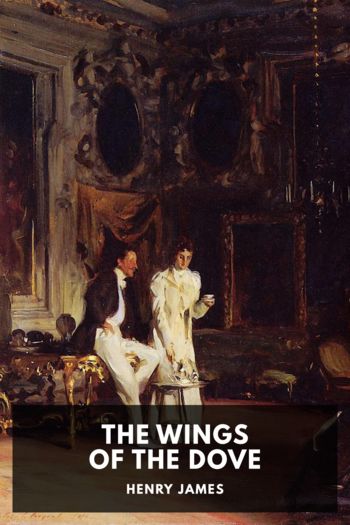Da Vinci's Bicycle, Guy Davenport [best motivational books to read TXT] 📗

- Author: Guy Davenport
Book online «Da Vinci's Bicycle, Guy Davenport [best motivational books to read TXT] 📗». Author Guy Davenport
She rides, this Jeanne or Louise, with the poise of an Iroquois and the hauteur of a Cherokee. She wears, transactu tempore, like her flowery troop, braccae phrygiae, persimmon trousers open on a dapper bias from hip to inner thigh, tucked into canvas boots.
She wears, like the boys, a buttonless vest embroidered with frets and florets, a neckerchief as yellow as the Icelandic buttercup, and a tam sporting the gray and white ribbons of the Phalanx Jules Laforgue, Escadrille Orage XI, Grammarian First Class.
They are off, quaggas, girls, boys, and a shuffle of forty raccoons kept in pod by Weimaraner corporals. Of going a progress the raccoons understand nothing, but Weimaraners trained to shepherd raccoons on marches between phalanxes they understand.
The Weimaraners understand the Little Hordes, Quagga masters and spadgers after Harmonian honor, gosling cadets in the affinities, the gammes, who are out to gather optima, centibonum by centibonum, pips and stars and blue ribbons and duck feathers.
For getting the raccoons from phalanx to phalanx hale and chipper, five centibona. For taking over the chores of the local goslings, fifteen. For general good nature, judged by the Police of Tone and Manners, twenty. For coining a new word, twenty-five.
IX
For spending the day with an elder and looking intelligently at everything shown and listening with full attention to everything told, ten centibona. And then there were the decorations differing from phalanx to phalanx given for the fun of distinctions.
These were in millicupidon points convertible through Common Measure into centibona, called mush in Horde argot, for freckles, bluest eyes, messiest hair, dirtiest feet, mentula longissima, silliest giggle, slyest wink, grubbiest fingernails, charm.
Goldenest smile, earliest pubic hair, nautch in the innominata, largest number of warts, longest period between the frumps, slickest kiss, keenest whistle, worst joke, roundest behind, highest pisser, brightest glow from a dandelion under the chin.
A wark in the gaster, a curr in the jaws, and she flies in a figure eight. She bounces in the air, trig of girth and smelling of ginger-flower wax, of apples, of vespa. She thirls her wings, clapfling and brake flip, shimmering her neb. She dips.
He zips in for a squinny, mucin in his ringent jaws, buzzing. She hums. He rimples his golden crissum, sprag for a hump. He brushes her antennae with his forelegs, she his. They dance, a jig, insect of ictus, in linked orbits, more wiggle than step.
Zizz! She pounces, lifts him with all her legs, and flies up. He dangles, wings closed over feet. Over the rose she carries him, through the liliodendron, between the zinnias and sage, peonies, hollyhocks and comfrey, color milling in a quick of sugar.
Amma drew a plan of the world before he created it. He drew the world in water upon the emptiness of space. To draw the egg of Amma you draw a long table of signs and you call this the stomach of all that is. Put a navel at the center. One dot starts all.
Divide the table into quarters, north east south west. Divide each quarter into sixty-four parts. Count them: you have two hundred and fifty-six parts. Add two numbers for each crossline that first divided the table into quarters, and two for the navel.
These are the two hundred and sixty-six things out of which Amma made the world. The quarters are earth, fire, water, air. The crosslines are the bummo giri, the eye lines. Four pairs of signs in the quarters are masters of all the other signs of Amma.
X
What works in the angle succeeds in the arc and holds in the chord.
XI
At the Casa da Vinci you could see an owl from Germany, a book of drawings showing the inside of the body, bowels, lungs, a baby in the womb, muscles knit around joints and stretched from bone to bone, a bat, thunderstones, and an egg of the ostrich bird.
You could see the imp Salai, so accomplished a rogue at ten that you could picture his neck in a noose by twenty. Marco had gone at him with a knife and had been thrashed for it by Ser Leonardo himself, who rarely lifted an angry hand. But for Salai, O già.
Salai was beautiful. Ser Leonardo was said to be the handsomest man in all Tuscany. Sono belli tutti i bastardi! Gian Antonio, as good-natured as a puppy, had been the favorite before Salai, and therefore undertook to deprave him properly and for good.
To discover that he himself was not half as depraved as he thought he was. Human nature, Leonardo said, spreading his hands, is varied. Talents are to be nurtured. Genius in the young is as yet mere energy. Gluttony matures into taste, lust into love.
The pinnace of the Santa Maria bore upon Guanahanì on the other side of the world, its banner of Leon and Castille and standard of the Admiral of the Ocean Sea moving in a tossing majesty through strange, crying, wheeling seabirds, fowl of Cathay.
Trumpets, drums, fifes, tabors and pipes sounded a music appropriate to an arrival in China from all the way around the world, a pomp for the procession of dukes toward the queen. The cross was held high on the prow, in triumph, before the scarlet flags.
A little boy the meanwhile in Firenze was drawing a bicycle. He begins with the wheels, turning a compass inexpertly: they are not quite round. Then, with a brown crayon, he draws the spokes, frame, handlebars, seat, sprocket, chain, pedals.
The chain is exactly the same kind as we use now, but Salai does not understand in the drawing he is copying how it is to work. Ser Leonardo’s drawing has hachures and





Comments (0)